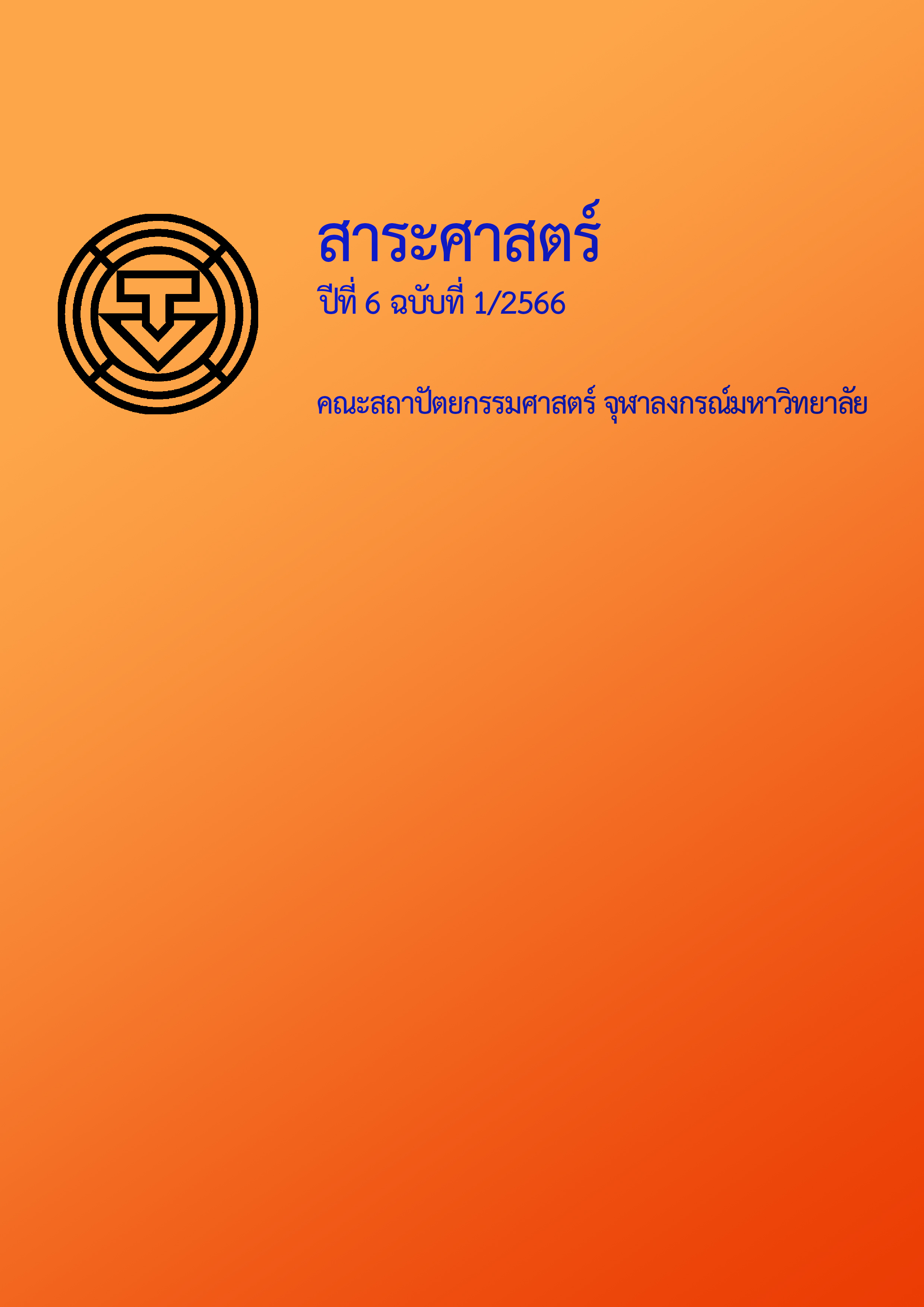The The Conservation and Development Guidelines for Chiang Saen Ancient City, Chiangrai Province
Main Article Content
Abstract
Chiang Saen ancient city is historic city, which is important because there is based foundation of large kingdom in the north such as the Lanna Kingdom, and fortress town that has unique physicality form located on the bend of the Mekong River, where the Golden Triangle meets the borders of three countries, that make urban structure consistent with its topography, and the way of life that shows the relationship between the community and ancient sites in terms of cultural religion. But, the previous master plan for preserving and developing the old city didn’t success because of emphasizing on external physical preservation and designing to clear separation between communities and ancient sites, resulting in both cultural heritage values in the ancient city of Chiang Saen and the relationship between the community and the ancient sites is decreasing.
The objective of this research is to study the historical and the current part of the Chiang Saen ancient city to present the guidelines of Chiang Saen ancient city as following Historic Urban Landscape. The study had included (1) principles and concepts of historical urban landscapes, (2) physical forms of the ancient city of Chiang Saen, and (3) community-based concepts, the way of life in community, and community activities. The research method focused on paper source, surveying sites, and interviewing with representatives both of the 6 communities and the committee of fine arts office 7 Chiang Mai.
The results show that Chiang Saen ancient city has the quality to apply Historic Urban Landscape because there is prominent physicality, which includes location, architecture, ancient sites, and landscape. And, the notable way of life that present religious relationship but there is problem form aptness of residents which most are elder and children, which are less interested and interact to city. Therefore, it is necessary creation guideline of conservation and development town with motivation to enter cultural and conservative activity, and supporting existing activities of community notably. It can propose guidelines consisting of 2 aspects: 1) physical aspect 2) education aspect. which all of aspect in guidelines must involve the community in expressing opinions to generate income and collaborate with relevant agencies for further sustainable conservation and development projects in the area.
Article Details
References
กระทรวงมหาดไทย. กรมโยธาธิการและผังเมือง. (2558). โครงการวางผังพัฒนาพื้นที่ประตูการค้าเพื่อเชื่อมโยงกับประเทศในภูมิภาคอาเซียน : จังหวัดเชียงราย. กรม.
เกรียงไกร เกิดศิริ. (2558). ข้อแนะนําเกี่ยวกับภูมิทัศน์เมืองประวัติศาสตร์. https://so04.tci- thaijo.org/index. php/NAJUA-Arch/article/view/65019/53233
เกรียงไกร เกิดศิริ. (2562). เมืองเก่าในประเทศไทย และแนวคิดภูมิทัศน์เมืองประวัติศาสตร์กับการอนุรักษ์และพัฒนาเมืองเก่า. https://issuu.com/be.su.research/docs/
ธวัช มณีผ่อง, ดรุณี แซ่โต้ว, อิงอร คงเจริญ, อำไพ สุปรากร, และบุญเสริม สมพันธ์. (2546). ประวัติศาสตร์ชุมชนท้องถิ่นกับการจัดการทรัพยากรสาธารณะของชุมชนริมฝั่งแม่น้ำโขง อ.เชียงแสน จ.เชียงราย : รายงานวิจัยฉบับสมบูรณ์. สำนักงานกองทุนสนับสนุนการวิจัย.
ภาสกร วงศ์ตาวัน. (2555). กำเนิดและล่มสลายเมืองโบราณเหนือแผ่นดินสยาม. ยิปซี.
มหาวิทยาลัยมหาสารคาม. คณะสถาปัตยกรรมศาสตร์ ผังเมืองและนฤมิตศิลป์. (2553). โครงการศึกษาแนวทางการจัดการมรดกทางวัฒนธรรม ผ่านกระบวนการมีส่วนร่วมของชุมชนและท้องถิ่นเมืองเชียงแสน จ.เชียงราย (รายฉบับที่ 1-2). มหาวิทยาลัย.
ยุทธนา พยุยงค์. (2546). การอนุรักษ์และพัฒนาเมืองประวัติศาสตร์เชียงแสน จังหวัดเชียงราย [วิทยานิพนธ์ปริญญามหาบัณฑิต ไม่ได้ตีพิมพ์]. จุฬาลงกรณ์มหาวิทยาลัย.
ศรีศักร วัลลิโภดม. (2538). ค้นหาอดีตของเมืองโบราณ. เมืองโบราณ.
สุรพล ดำริห์กุล. (2545). ข่วงเมืองและวัดหัวข่วงกับแบบแผนของเมืองในดินแดนล้านนา. มหาวิทยาลัยเชียงใหม่.
สำนักศิลปากรที่ 7 เชียงใหม่. (2549). โครงการจัดทำแผนแม่บทการพัฒนาเมืองโบราณเชียงแสนให้เป็นมรดกโลก. มหาวิทยาลัยเชียงใหม่.
เอกสิทธิ์ เรือนทอง. (2556). พัฒนาการของแผนผังโบราณสถานในเมืองโบราณเชียงแสนและเชียงแสนน้อย [วิทยานิพนธ์ปริญญามหาบัณฑิต ไม่ได้ตีพิมพ์]. มหาวิทยาลัยศิลปากร.
Bandarin, Francesco, & van Oers, Ron. (2012). The historic urban landscape: Managing heritage in an urban century. Oxford.
GML Heritage. (2022). The future for urban conservation—The HUL approach. https://www.gml.com.au/news/the-future-for-urban-conservation-the-hul-approach/
UNESCO. (2005). World heritage and contemporary architecture – Managing the historic urban landscape. https://unesco.lt/uploads/file/failai_VEIKLA/kultura/RA_Vienna_memorandum.pdf
UNESCO. (2010). Managing historic cities / Gérer les villes historiques. https://books.google.co.th/books?hl=th&lr=&id=p8_vCAAAQBAJ&oi=fnd&pg=PA7&dq=Historical+Urban+Landscape&ots=vbaH_2Ud_P&sig=qSLxnQsZTgFUzHUAEKQtt3obSMQ&redir_esc=y#v=onepage&q=Historical%20Urban%20Landscape&f=false
UNESCO. (2011). Recommendation on the historic urban landscape. https://whc.unesco.org/uploads/activities/documents/activity-638-98.pdf
UNESCO. (2013). New life for historic cities: The historic urban landscape approach explained. https://whc.unesco.org/uploads/news/documents/news-1026-1.pdf
UNESCO. (2015). The HUL guidebook. http://historicurbanlandscape.com/themes/196/ userfiles/download/2016/6/7/wirey5prpznidqx.pdf
Wimonrart Issarathumnoon. (2020). Applying the historic urban landscape approach to the identification of urban heritage attributes of Bangkok’s old town, Thailand. https://ph01.tci-thaijo.org/index.php/nakhara/article/view/240647/165909


